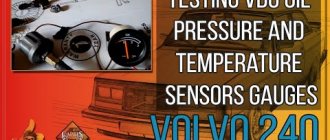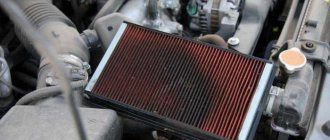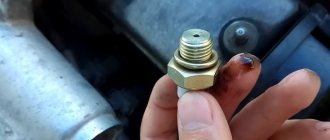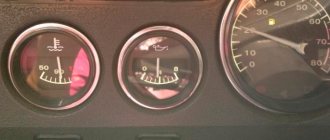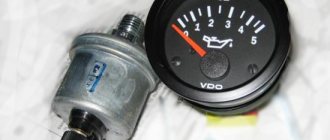It is well known that an internal combustion engine is a power unit that contains a large number of loaded parts and components. For normal operation of the internal combustion engine, such parts require constant lubrication, which is provided by the engine oil system. The working fluid in the system is engine oil.
We also recommend reading the article about which oil is better to choose, 5W30 or 5W40. From this article you will learn about the main similarities and differences between motor oils with the specified viscosity, as well as the criteria for choosing one option or another, taking into account various factors.
In the lubrication system, oil is supplied through separate channels under a certain pressure, which makes it possible to effectively lubricate parts experiencing dynamic and other loads. In this case, during the operation of the engine, you may encounter a loss of oil pressure in the engine. The driver may notice that the oil pressure lamp is blinking when the engine is warm, the oil pressure drops at idle speed, etc.
In this article we intend to talk about what oil pressure should be in the engine, why there is no oil pressure in the engine, and also how to check the oil pressure in the engine on a gasoline or diesel internal combustion engine using accessible methods. At the same time, the question of what an engine additive does to increase oil pressure and how effective such a solution can be considered will be considered.
Low engine oil pressure: causes of malfunction
As already mentioned, a decrease in oil pressure is indicated by the lighting of the warning light on the instrument panel. Note that the indicated oil light does not have to be on constantly. There are cases when the oil pressure light comes on when the engine warms up, but there is no such problem on a cold unit.
A similar situation occurs with idle speed. At idle, the oil light comes on or blinks, but after increasing the speed to a certain value, it quickly goes out. In such cases, it is necessary to stop operating the car and find out why there is no oil pressure in the engine, the causes of the malfunction, and also decide on ways to eliminate them.
- First of all, it is necessary to inspect the internal combustion engine from above and below for obvious oil leaks, and check the oil level in the engine. Insufficient lubricant will cause pressure to drop and oil starvation to occur.
It is important to consider that if there are no leaks, but the engine was spinning at high speeds for a long time before the light came on and was under high loads, then it is quite possible that oil consumption will increase due to waste and the lubrication level will decrease for natural reasons.
- The next step is to check the condition of the oil itself. It is not allowed to use a material that is too “liquid” or viscous, which is not intended for this type of engine by the internal combustion engine manufacturer. It is the first case that often leads to the fact that low-viscosity oil is not able to create the required pressure.
Let us add that for this reason the oil pressure often drops on a warm engine (the gaps between parts increase with heating, and the rising temperature causes the lubricant to become very thin). At the same time, while the engine and oil are cold, the lubricant viscosity is sufficient, that is, the light does not light up.
- Another emergency reason for a decrease in oil viscosity is that working fluid from the cooling system (antifreeze, antifreeze) enters the lubrication system. As a result, coolant enters the engine crankcase and the oil is diluted with coolant. While the oil pump is operating, the lubricant foams, the pump captures foam, and productivity decreases.
In other words, the lubrication system is not able to create the necessary pressure, and the oil itself loses its properties. The cause of coolant ingress may be a crack in the cylinder head, destruction of the cylinder block gasket, etc.
You can identify the problem by the thick white exhaust, as well as by the presence of an emulsion on the oil filler cap or on the dipstick. Also an indirect sign is a decrease in the coolant level in the expansion tank of the cooling system, while the oil level in the lubrication system will increase.
- It should also be noted that the properties of the oil can be greatly influenced by the fuel entering the crankcase. If the engine is faulty (for example, there are problems with the quality and ignition of the fuel mixture, there is low compression in the cylinders, the injectors are leaking, etc.), then fuel is supplied to the combustion chamber, but no charge is burned.
In this case, gasoline or diesel fuel enters the crankcase through leaks in the piston rings, diluting the engine oil. Under such conditions, the viscosity of the oil will gradually decrease, and at a certain point pressure problems will arise. The problem can be determined by the operation of the engine and the condition of the lubrication.
If combustion does not occur in the cylinders, then the engine runs rough, runs intermittently, smokes, and overuses fuel. An increased oil level and a distinct smell of fuel in it, as well as light spots and severe dilution, will indicate the presence of fuel in the lubricant.
- The oil filter deserves special attention, as it may turn out to be a fake or defective. If the filter does not have a shut-off valve or lock washer, then after stopping the engine, lubricant from the channels and filter will drain into the crankcase.
Further startup results in insufficient pressure in the system for several seconds, since during this time the filter is filled with oil. Naturally, until the pressure rises, the oil light will light, then go out. However, the problem will repeat after each stop and subsequent start.
Severe contamination of the oil filter, as well as untimely replacement of it, can also lead to a similar effect. The shut-off or pressure relief valve in the system may become jammed due to trapped debris, deposits, etc.
- The oil pressure in a diesel engine or gasoline unit may also be low due to lubricant leaking from under the oil pressure sensor. In this case, the pressure in the sensor area will not be enough. The warning light may come on intermittently or constantly, at idle, while driving at low or high speeds.
Also, one should not exclude the possibility of problems with the lubrication system itself and individual elements. Oil pump problems often lead to a drop in pressure. Although manufacturers provide a performance margin, sooner or later the gaps between the pump gears and its body increase so much that the device does not create the required pressure.
During long-term operation or for other reasons, the oil receiver becomes heavily contaminated. Its mesh often becomes clogged, as a result of which lubricant is not supplied to the engine.
- Malfunctions of components and parts of the engine itself are also the cause of low pressure. In this case, we can talk about serious wear or damage, which leads to the fact that the oil does not meet the required resistance when supplied. It turns out that the pressure naturally drops.
Such a decrease in pressure can be caused by a worn crankshaft and its bearings, wear and tear in the area of the camshaft, CPG, piston rings, etc. Quite often, low lubricant pressure in such cases indicates the need for serious or even major engine repairs.
Consequences of ignoring the problem
Stopping the engine when the pressure lamp lights up is a mandatory measure. Ignoring the signal can result in very serious problems:
- As a result of “oil starvation”, the contacting surfaces of components and mechanisms will begin to work “dry”, which will lead to their intense wear and high heating. If you take a crankshaft, the main and connecting rod bearings will begin to melt and “wrap” around the journals, which will lead to jamming of the crankshaft;
- Lack of lubrication will lead to intense wear of the camshaft “bed”;
- Wear products - small metal shavings - will spread through the channels of the lubrication system, which can lead to their clogging. Also, chips can cause jamming of the pressure relief valve and damage to the oil pump gears.
Elimination of such malfunctions is only possible through a major overhaul of the power plant.
The oil pressure light came on: emergency
So, if the oil pressure light is on or blinking, this means that the pressure in the lubrication system has dropped, the engine must be turned off as soon as possible.
- Even if obvious leaks are not visually visible (for example, the valve cover is dry, there are no traces of oil on the cylinder block), and the oil level is low, then you should carefully inspect the installation location of the oil filter and oil pressure sensor.
Also, special attention should be paid to the front and rear crankshaft oil seals and the junction of the engine sump. Many cars will require a detailed inspection from below, which is difficult to do without a pit or lift.
For this reason, when inspecting the engine compartment from above, pay attention to the lower part of the gearbox. A leaking crankshaft rear oil seal causes lubricant to leak into this area.
- If a leak is detected, you need to add suitable oil (in case of severe leakage, overflowing slightly above the level is allowed). The engine can then be started. If the light goes out, then you can drive to the service station under your own power without loading the engine.
We also recommend reading the article about whether motor oils can be mixed. From this article you will learn whether lubricants of different brands (with different viscosities, base stocks and additive packages) are compatible with each other, as well as what oil can be added in case of a malfunction.
- If the lubricant level is low and there is no pressure, and no leaks are detected, then the lubricant needs to be added. After this, the engine is started to evaluate the color of the exhaust. Blue or bluish oily smoke from the exhaust pipe will indicate that the piston rings may be stuck, the rings are worn out, or there are problems with the cylinder bore (scuffing).
In other words, lubricant consumption is greatly increased (the engine eats oil). Increased pressure in the crankcase and problems with valve stem seals also lead to increased consumption. If after topping up the light does not light up or blink, then you can drive to the service station on your own, after which in-depth diagnostics are carried out.
Please note that if adding oil to the level does not solve the problem (the light on the panel is still on), then you cannot drive the car under your own power. It is also not recommended to tow the vehicle using a cable. It is best to call a tow truck to deliver the car for repairs.
Checking the lubrication system components
If replacing the sensor and ringing the wiring did not bring any results, and the lamp still works, you should look for the cause further.
The next steps are:
- REPLACE THE OIL FILTER. This element is equipped with a bypass valve and if this valve does not work, then after starting the engine the system needs time to pump oil (this problem manifests itself in the form of a constantly burning light after starting). Another problem associated with the filter is its severe clogging, which is why it creates a strong obstacle to the movement of oil, preventing it from rising to the cylinder head where the sensor is installed;
- REMOVE THE PAN AND INSPECTION THE OIL PICKUP. Over time, the intake mesh becomes clogged with various deposits (this is especially true with frequent changes of oil brands and the use of additives). Due to deposits, it is difficult for the pump to “pull” the required amount of working fluid from the pan, so the pressure will be insufficient;
- CHECKING THE OIL PUMP. Backlash and wear marks on the gears will indicate severe wear. Due to the gaps, the unit is simply not able to pump oil and a loss of pressure occurs;
- WE ASSESS THE CONDITION OF THE REDUCTION VALVE. This element is designed to relieve pressure when a certain value is exceeded. But if the valve gets stuck in the open position, it will leak oil, preventing the pump from pumping up the required pressure.
These indicate the causes of pressure drop associated with the lubrication system.
What you can do yourself
The problem of low oil pressure greatly complicates the relationship between lubricant consumption and level drop and the overall pressure in the system. In this case, a number of malfunctions can be eliminated independently.
- If leaks are detected, the problem is quite easy to localize and solve. For example, oil leakage from under the oil filter can be eliminated by tightening or replacing it. The problem with the oil pressure sensor, through which lubricant flows, is solved in a similar way. The sensor is tightened or simply replaced with a new one.
As for seal leaks, in this case you will need time, tools and skills. In this case, you can replace the front or rear crankshaft oil seal with your own hands in your garage with an inspection hole.
Oil leaks from under the valve cover or in the pan area can be eliminated by tightening fasteners, replacing rubber gaskets, and using special engine sealants. Violation of the geometry of the connecting planes or damage to the valve cover/pan will indicate the need to replace such parts.
- If the coolant gets into the engine oil, then you can remove the cylinder head yourself and replace the head gasket, while following all the recommendations regarding the removal and subsequent re-covering of the cylinder head. An additional check of the mating planes will indicate whether the cylinder head needs to be ground. If cracks are found in the cylinder block or head, repairs are also possible.
As for the oil pump, if this element wears out, it is better to immediately replace it with a new one. It is also not recommended to clean the oil receiver, that is, the part is completely changed.
- In the case where the problem in the lubrication system is not so obvious, and you have to repair the car yourself, then at the very beginning you should measure the oil pressure in the engine.
To solve the problem, as well as taking into account an accurate understanding of where the oil pressure in the engine is measured and how it is done, additional equipment must be prepared in advance. Note that there is a ready-made device for measuring engine oil pressure available for free sale.
As an option, a universal oil pressure gauge will “Measure”. This device is quite affordable and comes with everything you need. You can also make a similar device with your own hands. To do this, you will need a suitable oil-resistant hose, pressure gauge and adapters.
To measure, a ready-made or home-made device is connected instead of an oil pressure sensor, after which the pressure readings on the pressure gauge are assessed. Please note that ordinary hoses cannot be used for self-production. The fact is that oil quickly corrodes rubber, after which the detached parts can get into the oil system.
How to measure?
There may be several reasons, up to and including the fact that the measuring device has failed or the wire has come off it. But more on that below. Now it is important to determine the sequence of actions to identify the problem and fix it.
You can’t leave everything as it is, because you could end up with a major overhaul of the engine, which has always been expensive and troublesome. So the pressure drops. Let's start taking action. To carry out successful measurements, we need a device called an oil pressure meter (a simple dial pressure gauge).
It can also be a universal device that also measures fuel compression. Measuring fluid pressure in gasoline and diesel engines can be carried out with the same device.
Whatever your pressure gauge is called, its design is equally simple: a pipe and adapters (adapters) for connecting to the motor at the measurement points. Let's imagine that you have this device in your hands. What's next?
- Let the “heart muscle” of the car cool down.
- Unscrew the original sensor;
- We select an adapter of suitable diameter and screw it in instead of the sensor;
- We connect the device with the adapter;
- We start the engine and let it idle until it warms up;
- We check the compression level first at idle, and then at a higher frequency, say, 1000 rpm.
- We compare the obtained figures with the indicators specified in the technical documentation of the car (on gasoline and diesel engines of different sizes, at idle speed and after warming up, the control values of oil pressure differ significantly).
If the motor systems are working properly, if it is set up correctly, then your measurements will fluctuate within the limits set by the manufacturer. If the indicators deviate from the norm upward or downward, we can talk about a malfunction of the oil pump, fuel leakage, contamination of the oil supply channels and other problems.
Let's sum it up
Considering the above, we can draw a brief conclusion why there is no normal oil pressure in the engine. The main reasons are:
- Loss of viscosity-temperature characteristics of the oil due to its quality.
- Leakage of lubricant through joints and seals.
- Malfunction of elements of the engine lubrication system.
- Wear or malfunction of components and assemblies of the power plant.
- The use of additional additives and additives to the base oil to artificially increase pressure.
- Possibility of failure of electrical parts of the lubrication system.
